The Graduate Nursing Project collection includes Doctor of Nursing Practice (DNP) Scholarly Projects and Master's students' non-thesis projects submitted as part of program requirements.
TO
Filters: Collection: ehsl_gradnu
| Title | Description | Creator | Subject | ||
|---|---|---|---|---|---|
| 51 |
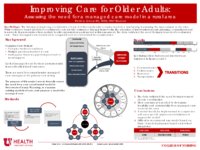 |
Improving Care for Older Adults: Assessing the Need for a Managed Care Model in a Rural Area | POSTER | Green, Patricia | Advanced Practice Nursing; Education, Nursing, Graduate; Managed Care Programs; Rural Health Services; Aged; Patient Satisfaction; Primary Health Care; Quality Indicators, Health Care; Needs Assessment; Delivery of Health Care; Quality of Health Care; Patient-Centered Care; Health Services for the A... |
| 52 |
 |
One Year Review of Experience with Post-Partum IUD Insertions | POSTER | Radmall, Jessica | Advanced Practice Nursing; Education, Nursing, Graduate; Midwifery; Perinatal Care; Postpartum Period; Contraceptive Devices; Long-Acting Reversible Contraception; Contraception Behavior; Time Factors; Pregnancy; Pregnancy, High-Risk; Equipment Failure; Uterine Perforation; Practice Guidelines as To... |
| 53 |
 |
Defining Current Practice of Iron Deficiency Screening Among High-Risk Neonates | POSTER | Willes, Dallin | Advanced Practice Nursing; Education, Nursing, Graduate; Pregnancy in Diabetics; Intensive Care, Neonatal; Infant, Very Low Birth Weight; Infant, Small for Gestational Age; Infant, Premature, Diseases; Anemia, Iron-Deficiency; Iron Deficiencies; Neonatal Screening; Risk Factors; Quality of Health Ca... |
| 54 |
 |
Adverse Maternal Event Screening Tool | POSTER | Rose, Camilla | Advanced Practice Nursing; Education, Nursing, Graduate; Maternal Welfare; Parturition; Maternal Mortality; Postpartum Period; Depression, Postpartum; Maternal Health Services; Mental Health; Pregnancy Outcome; Stress Disorders, Post-Traumatic; Psychosocial Support Systems; Practice Guidelines as To... |
| 55 |
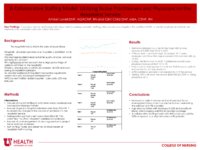 |
A Collaborative Staffing Model: Utilizing Nurse Practitioners and Physicians on the Hospitalist Service | POSTER | Lovell, Amber | Advanced Practice Nursing; Education, Nursing, Graduate; Hospitalists; Nurse Practitioners; Physicians; Personnel Staffing and Scheduling; Workload; Diagnosis-Related Groups; Length of Stay; Burnout, Professional; Needs Assessment; Diagnosis-Related Groups; Patient Volume; Collaborative Staffing; Po... |
| 56 |
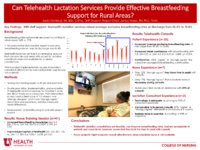 |
Can Telehealth Lactation Services Provide Effective Breastfeeding Support for Rural Areas? | POSTER | Dahlsrud, Sadie | Advanced Practice Nursing; Education, Nursing, Graduate; Telemedicine; Prenatal Education; Breast Feeding; Lactation; Rural Health Services; Health Services Accessibility; Hospitals, Rural; Feedback; Remote Consultation; Population Health; Women's Health; Health Promotion; Quality Improvement; Poste... |
| 57 |
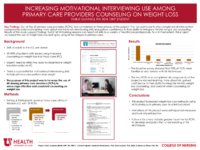 |
Increasing Motivational Interviewing Use Among Primary Care Providers Counseling on Weight Loss | POSTER | Gunnell, Emilie | Advanced Practice Nursing; Education, Nursing, Graduate; Obesity; Weight Loss; Motivational Interviewing; Bias, Implicit; Counseling; Inservice Training; Primary Health Care; Clinical Competence; Quality Improvement; Poster |
| 58 |
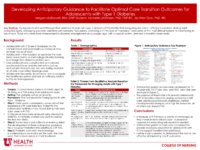 |
Developing Anticipatory Guidance to Facilitate Optimal Care Transition Outcomes for Adolescents with Type 1 Diabetes | POSTER | McDowell, Megan | Advanced Practice Nursing; Education, Nursing, Graduate; Diabetes Mellitus, Type 1; Adolescent; Psychosocial Functioning; Mental Health; Hyperglycemia; Outcome and Process Assessment (Health Care); Transition to Adult Care; Self Efficacy; Health Knowledge, Attitudes, Practice; Preconception Care; Gu... |
| 59 |
 |
Factors Influencing Utah Nurse Practitioners' Decisions to Join Professional Associations | POSTER | Rowley, Thomas | Advanced Practice Nursing; Education, Nursing, Graduate; Nurse Practitioners; Societies, Nursing; Societies; Professional Competence; Health Occupations; Utah; Professional Practice; Professional Development; Mentoring; Licensure; Work Engagement; Social Networking; Poster |
| 60 |
 |
Effective Identification of Sepsis in the Emergency Department | Background: Severe sepsis is the leading cause of death at the University of Utah Hospital (UUH). In the University of Utah's emergency department (ED), sepsis capture and treatment remained at only 25%. We created an educational module and a sepsis checklist tool for the ED nursing staff which resu... | Singer, Jessica | Advanced Practice Nursing; Education, Nursing, Graduate; Patient Outcome Assessment; Sepsis; Checklist; Emergency Service, Hospital; Treatment Outcome; Multiple Organ Failure; Kaplan-Meier Estimate; Resuscitation; Glasgow Coma Scale; Clinical Protocols; Practice Guidelines as Topic; Evidence-Based ... |
| 61 |
 |
Improving Pelvic Floor Dysfunction Screening in Primary Care | Background: Dysfunction means that something is not working appropriately. The pelvic floor is composed of a network of muscles, ligaments, and tissues that act like a hammock to support the organs of the pelvis: the uterus, vagina, bladder, urethra, and rectum. If the muscles of these organs become... | Hill, Alycia | Advanced Practice Nursing; Education, Nursing, Graduate; Pelvic Floor; Pelvic Floor Disorders; Diagnostic Screening Programs; Sensitivity and Specificity; Algorithms; Women; Health Knowledge, Attitudes, Practice; Health Literacy; Primary Health Care; Postnatal Care; Health Personnel; Attitude of Hea... |
| 62 |
 |
Motivational Interviewing for Substance Use Counseling in the Juvenile Justice Setting: A Nursing Staff Quality Improvement Project | The majority of youth in juvenile justice facilities have substance use disorders. Motivational interviewing (MI) has been found to be an effective counseling style for substance use among adolescents. The purpose of this study was to evaluate the effectiveness of a brief MI training for nurses and ... | Leavitt, Jessica L. | Advanced Practice Nursing; Education, Nursing, Graduate; Systems Analysis; Substance-Related Disorders; Alcohol Drinking; Health Risk Behaviors; Adolescent; Nursing Staff; Inservice Training; Motivational Interviewing; Counseling; Intention; Patient Care; Role Playing; Health Knowledge, Attitudes, P... |
| 63 |
 |
Utah's Opioid Overdose Epidemic: Co-prescribing Naloxone for Long-term Opioid Users | Background: Accidental opioid overdose is the leading cause of injury deaths in the state of Utah, even surpassing motor vehicle accidents. On average, 52 Utah adults die every month from drug poisoning. Currently, Utah is ranked 7th highest in the nation for opioid related overdoses. Co-prescribing... | Brearton, Klinton L. | Advanced Practice Nursing; Education, Nursing, Graduate; Opioid Epidemic; Prescription Drug Misuse; Drug Overdose; Opioid-Related Disorders; Social Problems; Substance-Related Disorders; Naloxone; Practice Patterns, Physicians'; Health Knowledge, Attitudes, Practice; Health Surveys; Liability, Legal... |
| 64 |
 |
Recognize and Treat Intracranial Hypertension to Improve the Quality of Patient Outcomes Who are Treated in the Neuro Critical Care Unit | Background Treating intracranial hypertension (IH) and brain herniation quickly and effectively is imperative in reducing morbidity and mortality. Local Problem The Neuro Critical Care Unit (NCCU) at Intermountain Medical Center (IMC) is considered the leader within Intermountain Health Care (IHC) i... | Bentley, Kristy | Advanced Practice Nursing; Education, Nursing, Graduate; Stroke; Intracranial Hypertension; Time-to-Treatment; Standard of Care; Quality of Health Care; Patient Outcome Assessment; Intensive Care Units; Neurophysiological Monitoring; Electronic Health Records; Practice Guidelines as Topic; Inservice... |
| 65 |
 |
Sexuality Education within the Juvenile Justice Services | Over 71% of adolescents in the Utah Juvenile Justice System report being sexually active. With the national average in the United States being just over 40%, there is a significant increased risk for sexually transmitted infections (STI) and unintended pregnancies in this population. While adolescen... | Stratford, Shane | Advanced Practice Nursing; Education, Nursing, Graduate; Sexuality; Sex Education; Male; Female; Unsafe Sex; Health Risk Behaviors; Risk Reduction Behavior; Adolescent; Sexually Transmitted Diseases; Pregnancy in Adolescence; Preventive Health Services; Health Literacy; Health Knowledge, Attitudes, ... |
| 66 |
 |
Effectiveness of an Educational Intervention to Increase Naloxone Prescribing Practices Among Rural Providers to Decrease the Death Rate from Opiate Overdose | Background: The death rate from opiate overdoses has exploded into what health officials call an epidemic. Nationwide, over 42,000 opiate overdose deaths occurred in 2016 with 40% of those being attributed to prescribed opiates. Between 2015-2016, there was a 10% increase in the death rate from pres... | Robbins, Emily | Advanced Practice Nursing; Education, Nursing, Graduate; Naloxone; Opioid-Related Disorders;; Drug Overdose; Patient Education as Topic; Rural Population; Vulnerable Populations; Prescription Drugs; Narcotic Antagonists; Social Problems; Opioid Epidemic; Health Knowledge, Attitudes, Practice; Attitu... |
| 67 |
 |
An Evidence-Based Educational Intervention to Improve the Recognition and Photo Documentation of Child Abuse Injuries in a Rural Health Facility | Background: Child abuse is an unfortunate reality for millions of children across the United States every year. The consequences of abuse result in long term emotional problems, including aggressive behavior, depression, anxiety, and thoughts of suicide; physical consequences include risk of asthma,... | Byrd, Tami L. Fikstad | Advanced Practice Nursing; Education, Nursing, Graduate; Child Abuse; Child Protective Services; Sentinel Surveillance; Rural Population; Mandatory Reporting; Health Knowledge, Attitudes, Practice; Hotlines; Self-Evaluation Programs; Early Medical Intervention; Primary Prevention; Cost of Illness; P... |
| 68 |
 |
Implementing Screening for Venous Thromboembolism in an Urgent Care Setting: A Quality Improvement Pilot Project | Background: Venous thromboembolism (VTE), which includes both deep vein thrombosis and pulmonary embolism, may have serious health consequences for patients. However, over-referral of patients with these suspected symptoms may also result in burden to emergency departments and health care systems. E... | Turgoose, William | Advanced Practice Nursing; Education, Nursing, Graduate; Venous Thromboembolism; Pulmonary Embolism; Physical Examination; Diagnostic Techniques and Procedures; Sensitivity and Specificity; Signs and Symptoms; Emergency Service, Hospital; Ambulatory Care; Referral and Consultation; Evidence-Based Pr... |
| 69 |
 |
Assessing and Improving Health Care Provider's Knowledge and Treatment of Panic-like Anxiety and Unexplained Chest Pain in the Emergency Department | This project assesses the knowledge and attitudes of health care providers (HCPs) in the emergency department (ED) of a 120-bed teaching hospital, regarding patients who present with unexplained chest pain (UCP), who may be suffering from panic-like anxiety (PLA). Several researchers have found that... | Hermansen, Gary | Advanced Practice Nursing; Education, Nursing, Graduate; Health Knowledge, Attitudes, Practice; Attitude of Health Personnel; Inservice Training; Panic Disorder; Anxiety Disorders; Chest Pain; Symptom Assessment; Diagnostic Screening Programs; Quality of Life; Psychosocial Support Systems; Emergency... |
| 70 |
 |
Improving Awareness and Cultural Humility Through a Self-Study Module | Purpose: The purpose of this quality improvement project is to improve healthcare worker awareness and cultural humility through a self-study training module as a means of improving patient care. Background. The United States has experienced an increase in the growth of minority populations, which i... | Schultz, Catherine H. | Advanced Practice Nursing; Education, Nursing, Graduate; Cultural Competency; Ethnic and Racial Minorities; Minority Groups; Quality of Health Care; Patient-Centered Care; Health Knowledge, Attitudes, Practice; Attitude of Health Personnel; Culturally Competent Care; Self Efficacy; Patient Satisfact... |
| 71 |
 |
Is Milrinone Safe and Effective for Infants with Congenital Diaphragmatic Hernia? | Pulmonary hypertension and related left ventricular dysfunction are common problems in congenital diaphragmatic hernia (CDH). Milrinone, a phosphodiesterase-3 inhibitor with lusitropic and vasodilator effects, is utilized in up to 30% of CDH cases nationwide. No randomized trials have tested efficac... | Mears, Michelle | Advanced Practice Nursing; Education, Nursing, Graduate; Milrinone; Hernias, Diaphragmatic, Congenital; Hypertension, Pulmonary; Infant, Newborn; Ventricular Dysfunction, Left; Respiratory Insufficiency; Extracorporeal Membrane Oxygenation |
| 72 |
 |
Bone Marrow Transplant Survivorship Care Plan: Bridging the Knowledge and Care Access Gap: A Pilot Study | In 2006, the Institute of Medicine (IOM), now known as National Academy of Medicine (NAM), recognized that there is a lack of continuation of cancer survivor care in the United States. The IOM recommended that all comprehensive cancer centers address the need of survivor care by using survivorship c... | Lee, Wenny | Advanced Practice Nursing; Education, Nursing, Graduate; Hematologic Neoplasms; Bone Marrow Transplantation; Graft vs Host Disease; Cancer Survivors; Survivorship; Cancer Care Facilities; Follow-Up Studies; Secondary Prevention; Electronic Health Records; Primary Health Care; Health Knowledge, Attit... |
| 73 |
 |
Development of a Pilot Comfort Care Guideline and Education Program with an Emphasis on Continuous Opioid Infusions | Background: The hospital model of acute care is antithetical to the major underpinnings of hospice care, however many patients will die in hospitals. Clinicians are often not focused on patient comfort care and feel uneasy managing opioid infusions commonly used in EOL. The use of comfort care order... | Cotner, Melissa | Advanced Practice Nursing; Education, Nursing, Graduate; Conflict of Interest; Ethics, Clinical; Health Knowledge, Attitudes, Practice; Analgesics, Opioid; Infusions, Intravenous; Pain Management; Analgesia, Patient-Controlled; Terminal Care; Practice Guidelines as Topic; Algorithms; Decision Trees... |
| 74 |
 |
Code Stroke: Effects of a Protocol Revision: A Quality Improvement Project | Introduction: Acute strokes in the inpatient setting comprise 6-15% of all strokes annually and are associated with worse functional outcomes and a larger financial burden than those with outpatient onset (Blacker, 2003; Cumbler, 2015; Bekelis, Missios, Coy, & Mackenzie, 2016). Approximately 32,000 ... | Graham, Patrick J. | Advanced Practice Nursing; Education, Nursing, Graduate; Inpatients; Brain Ischemia; Stroke; Neuroimaging; Tomography, Emission-Computed; Reperfusion; Time Factors; Clinical Protocols; Practice Guidelines as Topic; Emergency Service, Hospital; Quality Improvement |
| 75 |
 |
Cervical Collar Removal Times at a Level 1 Trauma Center: A Needs Assessment | Trauma patients remain in cervical collar neck braces for up to 12 hours awaiting final radiology readings. These final readings are necessary before the collar can be removed. The extended wearing of cervical collars potentially leads to worsening fractures, ligamentous injury, increased spinal mov... | Teas, Amelia H. | Advanced Practice Nursing; Education, Nursing, Graduate; Spinal Injuries; Trauma Centers; Needs Assessment; Electronic Health Records; Glasgow Coma Scale; Time-to-Treatment; Time Factors; Neck; Traction; Device Removal |
